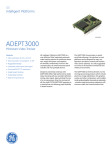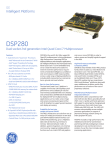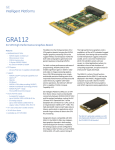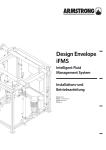Download GE ADEPT3100 Brochure
Transcript
GE Intelligent Platforms Unmanned Aerial Systems Leadership in UAV technologies since the very beginning The concept of the unmanned aerial system (UAS), which consists of an unmanned aerial vehicle (UAV) as well as the ground control ecosystem that supports it, is revolutionizing the way military information is gathered and even how adversaries are engaged. GE Intelligent Platforms has been there every step of the way, with a wide range of embedded computing products specifically tailored to meet the size, weight, and power (SWaP) constraints of UAV designs. The use of UASs is expected to grow dramatically as unmanned platforms weigh heavily into the announced plans of the U.S. Department of Defense and defense departments in other nations as well as non- 2 un m a n n ed aerial s y s tems de f ense.g e -ip.com /uas military entities such as police and border patrol agencies. Military, security agency and emergency response leaders recognize that UASs provide a means of reducing risk to personnel, conducting missions under conditions that would preclude the use of manned flight platforms. UASs also lower capital and operating expenditures for battlefield deployments as well as security, emergency and police patrols. response must be rapid, and not only with the correct solution for today but also with a clear technology roadmap for phased platform upgrades and modernization. Of course, all of this must be accomplished at a winning cost level, with open systems architecture and within the guidelines of the acquisition reform directives. GE products helped to launch early UAV platforms, and we continue to develop products that will help advance UAS future operations. Our video capture and image processing technologies and single board computers (SBCs) are used on UAS programs such as the U.S. Navy Fire Scout. Subsequent deployments have included our PPCM2 6U VME Dual PowerPC SBC in the Watchkeeper ground station, PPC4A 6U VME SBC in the Predator ground station, IMP2A 3U CompactPCI and SBC340 3U VPX Intel® Core™ Duo SBCs in the Herti vehicle, and SBC310 3U VPX SBC on the South Korean MUAV vehicle and PPC9A 6U VME SBC in its ground station. Most recently, our target tracking technology was used in a successful DARPA-funded project to demonstrate the feasibility of autonomous UAV-to-UAV in-flight refueling. The avionics bus structure is a key element in every UAV design. MIL-STD-1553 is a proven technology that has now come full-circle to include its use on the newest commercial aircraft development at Airbus. The 1553 standard provides EMI performance, determinism, distributed control and a 40-year history as the standard in military and aerospace flight controls, weapons and communications systems. UAS developers face unique challenges. Due to their high capability and solid economic benefit, UAVs are needed urgently in the field, thus accelerating their acquisition timeline. The developer’s Of major importance are the video capture and data streaming capabilities needed both to control the UAV and obtain meaningful data about potential objects of interest on the ground. Enormous volumes of data must be captured, processed and transmitted seamlessly and in real time using SWaP-optimized components. In addition, the operation of a battlefield asset from potentially halfway around the globe poses unique flight management, control systems and perhaps even weapons management systems challenges. For these critical requirements, GE offers application-ready solutions able to accept the developer’s unique software (or software solutions developed by GE) that can meet accelerated timelines and environmental requirements. In addition, we provide a clear, understandable upgrade path throughout the lifecycle of the platform, all at a winning price level. With intelligence, surveillance and reconnaissance (ISR) a major mission of the UAS paradigm, state-of-the-art, real-time video tracking capability is certainly at the top of any platform developer’s list of critical mission requirements. GE’s advanced image processing products such as the ADEPT5000 have been designed to achieve robust multiple target tracking despite the presence of background clutter and obscuration. The seamless integration of these various technologies is essential. Our rigorous subsystem integration and testing programs are designed to free contractors and system integrators from the time-consuming and capital-intensive certification of subsystems, thus helping to speed the time from design to deployment. 3 Products GE specializes in the design of commercial off-the-shelf (COTS) rugged components and custom subsystems. The use of ruggedized commercial components and subsystems affords state-of-the-art technologies at the lowest cost and fastest timeto-market. In addition, such products greatly mitigate program risks for the prime contractor. Our leadership in ruggedization techniques ensures that our products will withstand the harsh environments encountered by a UAV throughout the full lifecycle of the platform. 4 un m a n n ed aerial s y s tems de f ense.g e -ip.com /uas Autonomous Video Tracking for Geo-Location and Refueling Video tracking capability is imperative on UAVs, which may find utility both for ISR and weapons deployment. GE is at the forefront of rugged video tracking systems designs that minimize SWaP parameters. Our ADEPT5000 Multi-Target Video Tracker incorporates advanced pre-processors that separate targets from background clutter, while multiple-target tracking software provides concurrent detection, cueing and tracking for up to five targets. As high-definition sensors become commonplace on UAVs, their increased bandwidth demands places significant processing overhead on traditional video tracking systems. The dedicated video architecture of the ADEPT5000 ensures that it can process the higher pixel densities, frame rates, and multiple targets with minimal latency. This makes the ADEPT5000 especially suited for closed-loop control applications. A wide range of high-bandwidth digital video interfaces are available, including high-definition video. The ADEPT5000 has a simplified structured approach which significantly reduces configuration time and complexity with a consequential cost saving. A comprehensive range of physical form factors are available with a common functional core, allowing a single integration process to be used for multiple-system designs. Careful consideration has been given to automating operation. The enhanced user interface, automated functions and advanced high-resolution, full-color symbology combine to significantly reduce operator workload. ADEPT5000 In keeping with GE’s leadership in the development of COTS-based technologies to reduce SWaP, our new ADEPT3000 Video Tracker and MIP3ES Electronic Video Stabilizer are SWaP-optimized image processing modules designed to be placed on small platforms such as hand-launched UAVs or small unmanned ground vehicles. The ADEPT3000 affords most of the functionality of larger video tracker, yet is only slightly larger than a microprocessor chip. The MIP3ES eliminates unwanted visible platform motion and vibration from sensor images using low-latency post-processing. GE has designed both solutions to be fully ruggedized to survive harsh military environments such as extreme temperatures, shock, vibration, and dust. Automatic tracking was an important development benchmark for the ADEPT3000, because many of the platforms in which this device will be deployed are unmanned and potentially only minimally controlled by human operators. These smaller platforms will also have extremely tight power restraints, so the ADEPT3000 was held to very low power consumption specifications. ADEPT3000 (actual size) With a footprint of just 24mm by 34 mm, the ADEPT3000 is slightly smaller than a single frame of 35mm photographic film. Despite the SWaP-defined architecture of the ADEPT3000, GE engineers were able to retain a strong set of functionalities. The single target tracker allows targets to be tracked automatically or under operator control. The ADEPT3000 also affords composite video input and output, and an onboard RS232 TTL serial port. With full knowledge that the ADEPT3000 will be deployed on platforms that may be likely to be operated and maintained under field conditions, the tracker was designed for ease of set-up and use with PC control software. 5 Products Improved Ground Station Operation through Compression and Visualization ICS-8580 Signals from video sources may be seamlessly merged into a real-time, interactive 360-degree panoramic image on a single monitor or multiple monitors with our IPS5000 Image Processing System. The UAV operator is able to interact with the collected imagery through a range of interface options including touch screen, joystick and game-style controller. The ICS-8580 Video Compression Engine was designed with SWaP-constrained UAVs in mind. As part of a system with a single board computer and PCI switch, this rugged, standalone video capture, compression, streaming and archiving module is capable of delivering high-quality video from a small XMC form factor. Requiring minimal integration and software development, the lightweight ICS-8580 consumes low levels of power despite its ability to support a variety of video formats with either two channels of highdefinition video or four channels of standard-definition video. 6 un m a n n ed aerial s y s tems de f ense.g e -ip.com /uas MAGIC1 The ICS-8580 uses the industry-standard H.264 video compression codec, but can be reconfigured to support alternatives such as JPEG2000. Supported inputs include HDMI, HD-SDI, SMPTE259M/292M, RS170 (NTSC PAL), HDTV and CxBS/Y-C/YPrPb. The ICS-8580 affords four channels of mono or two channels of stereo input, along with two channels of audio. Support is provided for Microsoft® Windows®, VxWorks®, Linux software API and device drivers. A video client/server application and local file archive are available. Video compression SDK/API provides fast integration into enterprise applications. Greater Autonomy through High-Performance Computing The rugged MAGIC1 Display Computer combines state-of-the-art CPUs with the latest Graphics Processing Units (GPUs) for unprecedented performance in a small form factor computer. The NVIDIA GT 240 GPU gives the MAGIC1 full General Purpose computing on Graphics Processing Units (GPGPU) capabilities for incredible 96-core parallel processing capabilities for radar, image processing and similar applications. To provide full application coverage and flexibility, the MAGIC1 offers state-of-the-art Intel and Freescale™ processors. System memory is made up of two banks of dual data rate SDRAM, with capacity up to 4 GBytes. Users have the choice of a dual channel GPU, with either the NVIDIA GT 240 GPU with 1 GByte of DDR3 memory, or an NVIDIA G73 GPU with 256 MBytes of GDDR3 SDRAM. Graphics memory is arranged in two banks and the GPU connects to the CPU through a dedicated 16-lane PCI Express™ link. Onboard storage is provided by a solid state disk drive, which boasts a capacity of up to 256 GBytes, sustained read performance of 45 MB/second, and a purge facility to allow data on the drive to be securely deleted in an emergency. The 3U VPX form factor of the GRA111 Graphics Board affords high-speed, 16-lane PCI Express connections to single board computers. The GRA111, which is built into the MAGIC1 Display Computer, affords the maximum communication bandwidth to a CPU. With a rich set of I/O, the GRA111 is designed to serve many of the most common video applications. Dual, independent channels mean that it is capable of driving RGB analog component video, digital DVI 1.0, and HDMI standards. In addition, the GRA111’s video input capability allows integration of sensor data using RS170, NTSC or PAL video formats. Environments such as CUDA, OpenCL and MATLAB are available for rapid application development. The MAGIC1 is available in three chassis configurations: Base-plate cooled when a suitable coldplate is available; convection cooled with integral fins; or forced air cooled through hollow sidewall heat exchangers when no external cooling mechanism is available. GRA111 7 Products In addition, the XMCGA6’s video input capability allows integration of sensor data using RS170, NTSC or PAL video formats. IPN250 GE also provides high-performance graphics engines in form factors appropriate for UAV platforms. The SE2 Graphics Engine melds Intel Core 2 Duo processing technology with NVIDIA graphics processing capabilities in a single-slot, VXS-enabled single board computer (SBC). Its GS45 memory controller features a scalable front-side bus (800 – 1066 MHz) with dual channel DDR2 memory interface and a 16-lane PCI express linked to the NVIDIA GPU. The ICH9M controller hub is featured on the SE2 providing one x4 PCIe port or 10 Gigabit Ethernet, integrated Gigabit Ethernet controllers, six ports high speed USB 2.0, one SATA port, and Intel HighDefinition Audio. SE2 offers an optional 10 Gigabit Ethernet controller linked to the I/O hub via 4-lane PCIe. Our XMCGA6 Graphics Engine brings revolutionary functionality in an XMC form factor. The XMCGA6 supports the 8-lane PCI Express implementation, providing the maximum available communication bandwidth to a CPU. With a rich set of I/O, the XMCGA6 is designed to serve many of the most common video applications. Dual, independent channels mean that it is capable of driving RGB analog component video, digital DVI 1.0, and RS170, NTSC or PAL standards. 8 un m a n n ed aerial s y s tems de f ense.g e -ip.com /uas GE’s IPN250 GPGPU Board provides unprecedented computing performance in a 6U OpenVPX form factor. The IPN250 enables CUDA, OpenCL, OpenGL, video and image processing applications developed on Intel- and NVIDIA-enabled PCs. By using the IPN250, system integrators can deploy a single COTS module where previously multiple disparate modules would have been required. The IPN250 combines NVIDIA’s latest GT240 96-core GPU with an Intel Core2 Duo processor operating at 2.26 GHz and 8 GBytes of DDR3 SDRAM to deliver up to 390 GFLOPS of performance per card slot, depending on the application. Our NPN240 GPGPU Multiprocessor utilizes two NVIDIA CUDA-capable GT240 96-core GPUs. As such, the NPN240 can deliver up to 750 GFLOPS peak per card slot, depending on the application. Linking multiple NPN240s to single or multiple hosts results in multi-node CUDA GPU clusters capable of thousands of GFLOPs. Thus, the rugged NPN240 is able to expand performance levels in UAV applications such as radar and image processing. As sensor technology evolves and also as platforms carry greater numbers of sensors, platform specifications will increasingly require 10GbE communications. Our rugged GBX460 Data Plane Switch provides 20x 10GbE and 16x GbE ports or optionally 24x 10GbE ports in a 6U OpenVPX form factor. One application for this high-density Ethernet switch would be the networking of GPGPUs with high-performance GPUs in CUDA clusters to process 300 MHz RADAR phased arrays. SWaP-Optimized Packaged Computers The exciting new COTS Rugged System (CRS) Control Computers enable UAS integrators to quickly achieve their platform goals while minimizing development risk. This line of SWaP-optimized packaged and pre-validated rugged computers affords a wide range of I/O options for UAV control and payload applications. Each CRS computer is deployable as soon as the field application is ready. The computers may also be used as starting points for multiple application-specific configurations. In addition, the CRS concept greatly reduces non-recurring engineering costs, and provides a fast track to an advanced technology readiness level. MIL-STD-1553 Avionics Products GE offers a wide range of 1553 products to support any UAS development effort from beginning to end. Our 1553 products are used in all phases of design, test, simulation, maintenance and support, as well as ground station control. Our rugged PC104 and PMC products are currently embedded and flying on UAV platforms. GE is the recognized leader in 1553 products, and we are now driving newer MMSI and 10 Mbit 1553 technologies. Our latest XMC product, the RXMC-1553, is ideal for embedded UAV applications. For flight testing, the BTP is a rugged, fully integrated 1553 test system that is ready to go right out of the box. The Q104-1553 is used for small form factor products required by the very limited space available on some UAV platforms. 9 Illustration to go here Situational Awareness A range of detection algorithms are built into the system to meet real-time situational requirements. Video from multiple cameras is merged into an interactive panorama view of an operational scenario. Integrated Subsystems Our integrated subsystems are on manned and unmanned aircraft, and ground and sea platforms. GE's expertise ranges from individual boards to fully integrated application subsystems for highly reliable mission and flight control systems. 10 un m a n n ed aerial s y s tems de f ense.g e -ip.com /uas Rugged Deployment Our rugged systems and modules for ground based platforms are designed to deliver high performance and reliability for the extreme conditions of field deployment from Arctic cold to Saharan heat and dust. Video Tracking/Mapping Superior target detection and tracking products, combined with image fusion and stabilization in the smallest ruggedized packages, provide the highest performance solutions. Shipboard Target Detection Our rugged image processing tools offer real-time video target detection and tracking, situational awareness, UAV data communication, mine detection and sensor control. 11 The sky is the limit The UAS concept has more than proved its effectiveness in military and many other deployments around the world. There is no doubt that the presence of UAV platforms will continue to grow as military, security and emergency response forces continue to extoll the merits of platforms that can accomplish more with less manpower and risk while costing much less than manned aircraft. Civilian government, scientific agencies and commercial operations are now looking toward UAV platforms for their own mission accomplishment. As the UAS concept of operations matures, we expect many exciting changes in how UASs are used for both military and civilian uses. With a desire to minimize operator involvement as much as possible in routine flight control, autonomous flight capabilities will be a major priority of many UAS customers. Coupled with this will be a greater level of high-performance computing so enable the UAV platforms to fly considerable distances under their own navigation and control. 12 un m a n n ed aerial s y s tems de f ense.g e -ip.com /uas Platform-centric systems and architectures that rely on proprietary interfaces will give way to a network-centric paradigm based on open architectures. Advances in open standards performance, such as OpenVPX high-speed serial fabrics, along with the ability to bridge legacy devices make it possible to develop scalable and interoperable network-centric subsystems with substantially lower development and logistical risks. System designs will incorporate ruggedized commercial off-the-shelf (COTS) components for the fastest time-to-market using the latest technologies. Traditionally, the inputs from platformspecific sensors are either hardwired directly to the processor or transmitted over MIL-STD-1553 or ARINC-429 buses. GE’s new high-speed, determinist Ethernetbased technologies for AFDX/ARINC 664, and our continued support of ARINC 429 and MIL-STD-1553B along with higher speed MIL-STD-1553 protocols and MMSI ensure our commitment to leading avionics products. Our wide range of products support many different interface technologies including newer standards like PCIe, XMC, VPX, AMC and Express Card, Mini PCIe, Low Profile PCIe—all with driver support for real-time operating systems. This approach allows for an incremental upgrade that matches today’s budget constraints, because it is unlikely that all older equipment can be replaced at the same time. There will be a period of time during which new electronic systems and older ones based on the legacy interfaces must coexist. Open interface standards such as VPX (VITA 46), OpenVPX (VITA 65), and VPX-REDI (VITA 48)–along with adoption of standardized high-speed interconnects like GbE and PCIe–overcome these challenges. Also critical to the equation is the ability to integrate legacy systems. Future mission requirements 6 6 6 6 6 6 6 6 Automated in-air refueling Strike capability See-and-avoid (collision avoidance) Air drop Operation in domestic airspaces Aeromedical missions Electronic warfare Cyber-warfare New UAV markets and customers 6 6 6 6 6 6 6 6 Law enforcement Agriculture Traffic control Firefighting Scientific research Environmental monitoring Energy and electrical facility monitoring Classified operations Applications 6 6 6 6 Situational awareness See and avoid Wide-area surveillance Flight management systems for persistent surveillance, targeting, strike and airdrop Technology building blocks 6 6 6 6 6 Autonomous control High-performance computing Image and data fusion Mosiacing, stitching, image exploitation, lossless compression, target classification, context-based data compression, hyperspectral analysis Full motion video 13 Support GE takes considerable pride in its Program Management (PM) and Product Lifecycle Management (PLM) services. Both programs have been shown to reduce program risk from cradle to grave while also reducing costs both in development and deployment. 14 un m a n n ed aerial s y s tems de f ense.g e -ip.com /uas Our PM service rigorously strives to eliminate the many avenues of risk in UAV program development. From develop of the product requirements and program schedule to the product qualification and release for production, we work closely with the customer to demonstrate our design and manufacturing progress as measured against the program baselines and forecasts. We make every effort to pair proven commercial products with UAS design projects because we realize that the introduction of new or customized technology is an avenue of risk. In the event that stock products cannot meet customer specifications, our PM staff will develop a customer-centric plan to shepherd the product development from prototype to production. For example, in a critical UAV subsystem, a Tier I provider approached us for assistance because they were experiencing unacceptable performance and schedule risk. GE, with a state-of-the-art GPGPU solution, was able to put them ahead of schedule and reduce each aspect of the SWaP profile while improving performance more than seven-fold. Price change risk is eliminated because our initial quote remains the price until delivery. In addition, our contract change management service reduces costly change orders by ensuring that every change has been formally approved by the customer and that a separate purchase order has been cut to reflect that change. Our PM service also provides the documentation of risk management that contractors can provide to higher-tier contractors who want to know that systems will be delivered on time and exactly to spec. Effective PLM ensures that parts are available to service routine and emergency maintenance. A PLM program can also anticipate technology advances and thus allow for upgrades to embedded technology with a minimum of hardware or software disruption. The result is the highest level of repeatable performance at the lowest possible cost of ownership across the UAS program’s lifecycle. GE’s long-established PLM team maintains close contact with component suppliers and industry groups such as the Component Obsolescence Group to constantly monitor technology developments and component obsolescence issues. At the heart of the program is a dedication to providing both progressive and defensive Long Term Support. Progressive support begins on the design table, with embedded products being designed for maximum compatibility or upgradability even before they are qualified for a system. The list of critical components will include only those elements for which vendors have committed to a long-term production run. occurs in the marketplace, GE’s Health Check program will alert the customer and provide possible solutions such as a last-time buy of the components, an appropriate replacement component, a redesign of the original product for form, fit, or function compatibility, technology insertion earlier than planned or a lifetime purchase of the components. When components are purchased in bulk, GE also can provide secure, climate-controlled storage for as long as required by the customer. Long-term product lifecycles demand that critical engineering knowledge is available regardless of personnel changes or corporate restructures. Similarly, testing, diagnostic and repair capabilities must be maintained. GE Intelligent Platforms’ PLM program ensures that such knowledge, protocols and capabilities are available throughout the lifecycle of the UAS. After a product is launched, defensive PLM provides the technical support and service to keep the product running, as well as ensuring that sufficient stores of spare parts are available to avoid the premature shutdown of a system or even the entire platform. When technology obsolescence 15 GE Intelligent Platforms Contact Information Americas: 1 800 433 2682 or 1 434 978 5100 Global regional phone numbers are listed by location on our web site at www.ge-ip.com/contact defense.ge-ip.com/uas ©2011 GE Intelligent Platforms, Inc. All rights reserved. *Trademark of GE Intelligent Platforms, Inc. All other brands or names are property of their respective holders. 08.11 GFA-1829






























